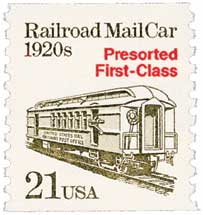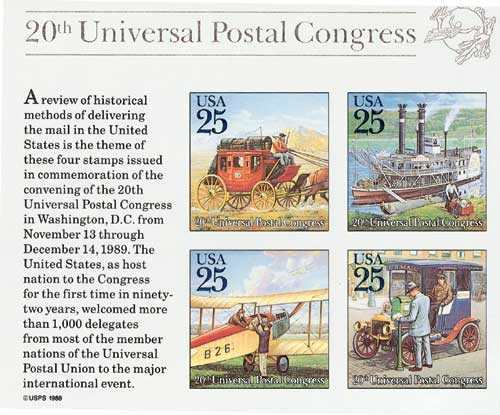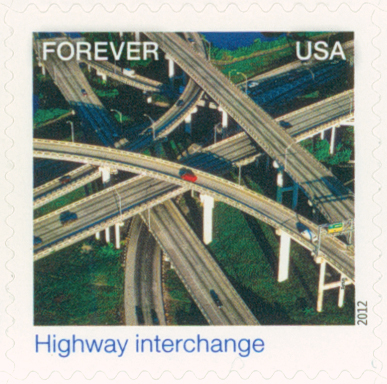
# 2438 - 1989 25c Traditional Mail Delivery, souvenir sheet
25¢ Classic Mail Transportation
20th UPU Congress Souvenir Sheet
City: Washington, DC
Quantity: 2,047,200
Printed By: Bureau of Engraving and Printing
Printing Method: Lithographed and engraved
Perforations: 11
Color: Multicolored
First Highway Post Office
In the 1800s, America’s rapid expansion created a need for faster mail transportation. The short-lived Pony Express of 1860-61 made it possible to send messages across the country in just 10 days. Then in 1862, the US introduced its first Railway Post Office (RPO), which sorted mail as the train steamed along.

At its height, these RPOs had over 9,000 train routes traveling over 200,000 miles. By the 1940s, highways were stretching across America, and the US Post Office Department began to consider creating Highway Post Offices (HPOs) to provide mail service to areas where there wasn’t passenger train service. HPOs would run in a very similar fashion, except the mail would be transported on a bus rather than a train.
The first HPO entered service on February 10, 1941, traveling 149-miles between Washington, DC and Harrisonburg, Virginia. Two more HPO routes opened later in the year, one between South Bend and Indianapolis, Indiana on May 3, and one between San Francisco and Pacific Grove, California on August 4.
The interior of the HPOs was very similar to that of the RPOs. Each bus could hold about 150 mailbags. Similar to RPOs, the clerks sorted the mail while the bus was in transit. To keep the mail safe, there was a locked gate between the driver (often a hired contractor) and the postal clerks. There were also bars on the windows.
25¢ Classic Mail Transportation
20th UPU Congress Souvenir Sheet
City: Washington, DC
Quantity: 2,047,200
Printed By: Bureau of Engraving and Printing
Printing Method: Lithographed and engraved
Perforations: 11
Color: Multicolored
First Highway Post Office
In the 1800s, America’s rapid expansion created a need for faster mail transportation. The short-lived Pony Express of 1860-61 made it possible to send messages across the country in just 10 days. Then in 1862, the US introduced its first Railway Post Office (RPO), which sorted mail as the train steamed along.

At its height, these RPOs had over 9,000 train routes traveling over 200,000 miles. By the 1940s, highways were stretching across America, and the US Post Office Department began to consider creating Highway Post Offices (HPOs) to provide mail service to areas where there wasn’t passenger train service. HPOs would run in a very similar fashion, except the mail would be transported on a bus rather than a train.
The first HPO entered service on February 10, 1941, traveling 149-miles between Washington, DC and Harrisonburg, Virginia. Two more HPO routes opened later in the year, one between South Bend and Indianapolis, Indiana on May 3, and one between San Francisco and Pacific Grove, California on August 4.
The interior of the HPOs was very similar to that of the RPOs. Each bus could hold about 150 mailbags. Similar to RPOs, the clerks sorted the mail while the bus was in transit. To keep the mail safe, there was a locked gate between the driver (often a hired contractor) and the postal clerks. There were also bars on the windows.








